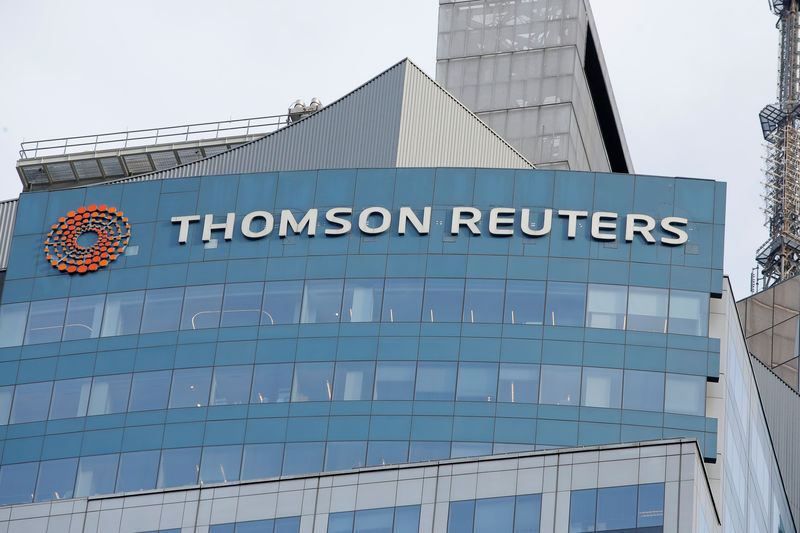By Jonathan Schwarzberg
NEW YORK, July 6 (LPC) - Rising pricing is creating a more challenging environment for large US buyout loans that were underwritten earlier this year, including a US$13.5bn loan and bond financing for Thomson Reuters Finance and Risk (F&R) unit and an US$8.05bn financing for physician services provider Envision Healthcare.
A wave of new issuance in May and June has given investors the upper hand with more deals to choose from. This is creating a less predictable market environment and pricing has widened out to an average 400bp from 325bp as a result, a banker said.
Average first-lien spread increased to 406bp during the second quarter from 368bp in the first quarter, according to data from Thomson Reuters LPC.
“For the first time in as long as I can remember lenders have the opportunity to push back on deals and get more spread…more discount… more call protection on new deals,” a senior loan investor said.
New money loans totaled US$33.5bn in June and US$54.2bn in May, which was the biggest monthly total since September 2017, when the figure hit US$70bn, according to Thomson Reuters LPC data.
Some deals are requiring revisions such as higher pricing, more call protection and documentation changes, while other transactions are clearing the market easily, as investors focus on credit fundamentals ahead of an anticipated downturn as US interest rates rise and the elongated credit cycle draws to an end.
“It's all about credit quality at the end of the day,” said a second loan investor. “We're looking closely at all the numbers on every deal differently.”
Some opportunistic refinancing transactions, including a US$1.5bn repricing for driveline manufacturer American Axle & Manufacturing, have been pulled recently as the market's attitude to risk grows more bearish amid dislocation in the high yield bond market.
“They (investors) are pushing back on repricing. Everyone's sick and tired of them and don't think that these should get done during a choppy market,” the first loan investor said.
Pricing on a US$1.75bn buyout deal for blood glucose monitoring systems marketer LifeScan widened during syndication to 600bp over Libor from 450bp over Libor on a US$1.475bn first-lien tranche and pricing on a US$350m second-lien tranche increased to 950bp over Libor from 850bp over Libor.
The issuer also cut the maturity of the first-lien loan to six years from seven years and the second-lien loan to seven years from eight years. Investors were worried that the company receives 85% of its revenue from glucose test strips.
Familiar credits with a good market track record are receiving a good response from investors. Battery maker Energizer Holdings Inc was able to cut pricing during syndication on a US$1bn term loan supporting its acquisition of Spectrum Brands' batteries and lights unit to 225bp over Libor from 250bp over Libor on June 21.
A US$350m add-on for waste services provider Clean Harbor was well received due to the company's solid track record and strong financials despite a low coupon of 175bp over Libor, which has proved difficult for less well liked companies.
Investors were last able to call the shots in late 2015 and early 2016 when falling oil and commodities prices raised fears over China's economy and created a huge downdraft that led to multiple hung deals, including a US$5.6bn financing that backed the buyout of software provider Veritas.
It is hard to compare current market conditions to that period, the investor said, adding that current conditions are more technical as the raft of recent supply has outstripped demand.
“Clearly we're going to get hit eventually, but this is more technical," said the first investor. "Nobody's really worried about defaults right now, the economy's in good standing and our portfolio companies are performing well.”
The deteriorating quality of deals is also giving investors ammunition to push back against more highly leveraged loans after regulators, including Comptroller of the Currency Joseph Otting, encouraged underwriters to push the limits.
Otting said in February that banks have the ability to underwrite deals outside of the leverage lending guidelines put in place to curb risky lending in 2013 as long as they have the capital to do and reiterated the statement in May.
“I think underwriters in their desire to be competitive to win business are pushing capital structures a lot harder,” the banker said.
COMING SOON
Wider primary pricing means that the large buyout deals backing Blackstone (NYSE:BX)'s purchase of Thomson Reuters' F&R unit and Envision may need to price higher than originally envisaged to clear the market. Both deals are expected to launch formally after Labor Day.
The US$13.5bn loan and bond financing for Thomson Reuters' F&R unit is viewed as an attractive deal due to its business line and strong financials and could price under 400bp as a result, the banker and investors said. The US$8bn Term Loan B and US$5.5bn bond bridge loan are currently being shown to large investors.
“If it ends up at 400bp, I would think what is being reflected in that price is a size premium,” the banker said, pointing out that the US$8bn term loan will require virtually everyone to participate, which could potentially give investors bargaining power.
Blackstone announced on January 30 that it was buying a 55% majority stake in Thomson Reuters' F&R unit, which includes LPC and IFR.
Envision's US$9.9bn buyout by private equity firm KKR & Co. is also expected to generate wide interest but the company's credit profile is expected to weaken with additional leverage. Both Moody's and S&P put the company on review for downgrade and said the company's leverage will increase from around 4.5 times prior to the buyout.
